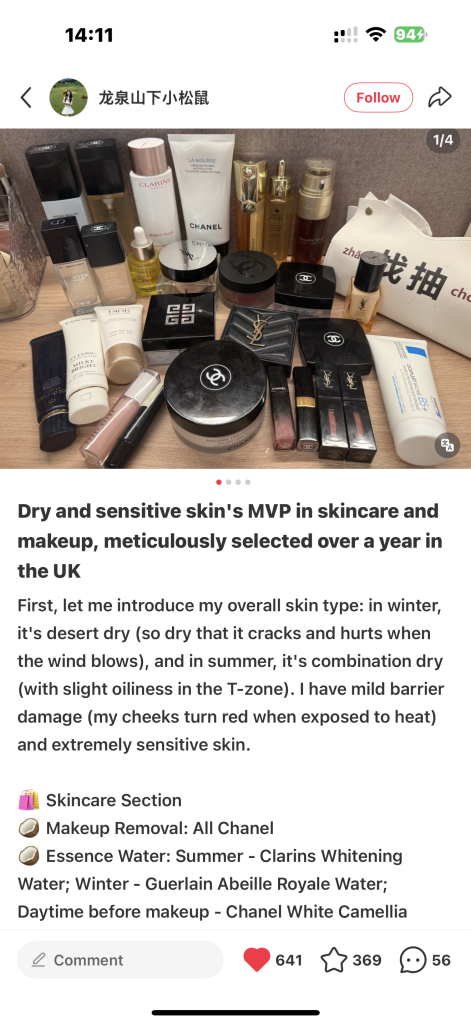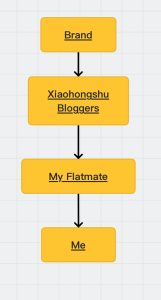Last week, my flatmate showed me a post on Xiaohongshu (Little Red Book) about a new serum that was getting very popular. She said the blogger explained the ingredients clearly and showed real results on her skin. Latter, my flatmate shared the post in our group chat, and a few days after that, I also decided to buy the same product. I didn’t read the original post carefully, but I trusted my friend’s opinion. This small moment made me think about how information actually reached us online.

The Two-Step Flow theory by Katz and Lazarsfeld (1955) explains that media messages are not always received directly by audiences. Instead, they often pass through opinion leaders who interpret and spread information to others. These leaders can be celebrities, experts, or ordinary individuals who are trusted within a small group. As McQuail (2010) later discussed, interpersonal communication can often be more persuasive than direct media exposure because it adds a sense of social proof and personal relevance.

In my example, the Xiaohongshu blogger acted as the first “step”, providing the initial information about the skincare product. My flatmate was the second “step”, an opinion leader within our small social circle. She was not famous, but she had credibility among us because she knew more about skincare and had similar skin concerns. her recommendation influenced my decision more than the original advertisement did. As Abidin (2016) points out, micro-celebrities and trusted peers play a crucial role in shaping our consumption choices through visibility and trust.
However, the Two-Step Flow theory has some limits in today’s digital environment. First, algorithms now decide who appears on our feed before we even see it, which adds more layers of mediation. Influence is no longer just two steps, it can be multiple and personalized. Second, many online recommendations are sponsored, and the line between honest opinion and advertisement is often blurred. This makes it harder for users to know whether a post is trustworthy or not.
I realized that I often trust my friends’ skincare suggestions more than official ads. When my flatmate shared the serum post, I believed her because she has sensitive skin like me. later, I also shared my review with another friend. In this process, I unknowingly became a small opinion leader myself. Now, I try to be more critical before following any recommendation. I check multiple reviews and think about whether someone might be promoting a product for profit.
The Two-Step Flow theory still helps explain how influence travels through our everyday networks. Even though social media and algorithms have changed the flow of information, human trust and relationships still play the most powerful role. Recognizing this helps me become a more reflective and responsible media user.
References
Abidin, C. (2016) ‘Visibility labour: Engaging with influencers’ fashion brands and #OOTD advertorial campaigns on instagram’, Media international Australia incorporating Culture & policy, 161(1), pp. 86–100. Available at: https://doi.org/10.1177/1329878X16665177.
Katz, E. and Lazarsfeld, P.F. (2006) Personal influence : the part played by people in the flow of mass communications. Second edition. New Brunswick, N.J: Transaction Publishers. Available at: https://doi.org/10.4324/9781315126234.
McQuail, D. (2010) McQuail’s Mass Communication Theory. 6th ed. London: SAGE.


This blog connects the Two-Step-Flow theory to a real life example. The use of Xiaohongshu post makes the concept easy to understand and shows how trust and personal relationships shape our decision. I totally agree that people trust interpersonal influencer more than direct advertising. I found that most of people around me do not look at official ads before buying something. Instead, they learn about products from influencers or friends. But it is interesting that, I realised that many influencers are doing paid promotion today, so people don’t really trust them anymore. My suggestion for you is that, the conclusion could be expanded to give readers more practical advice on developing media literacy and evaluating online recommendations.
I really enjoyed how you not only explained the two-step flow theory, but you also broke down how it directly impacted you as a consumer and as someone who looks at the social media posts and considers consumption of these products. The line “Influence is no longer just two steps, it can be multiple and personalized,” really stood out to me because it is so true! Although things are still marketed to us, it also really feels personal, which causes further interest in these products.